Innovative Stackable Pans: Design and Efficiency
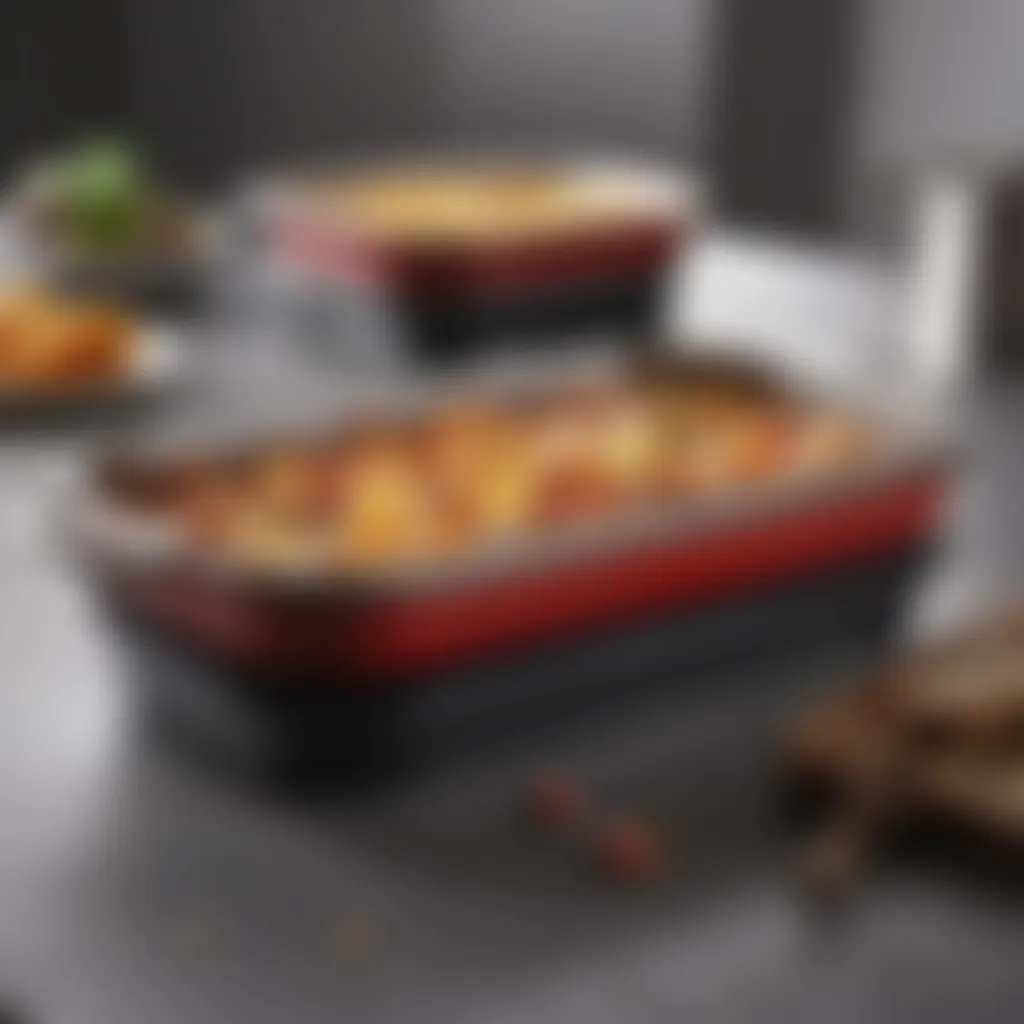
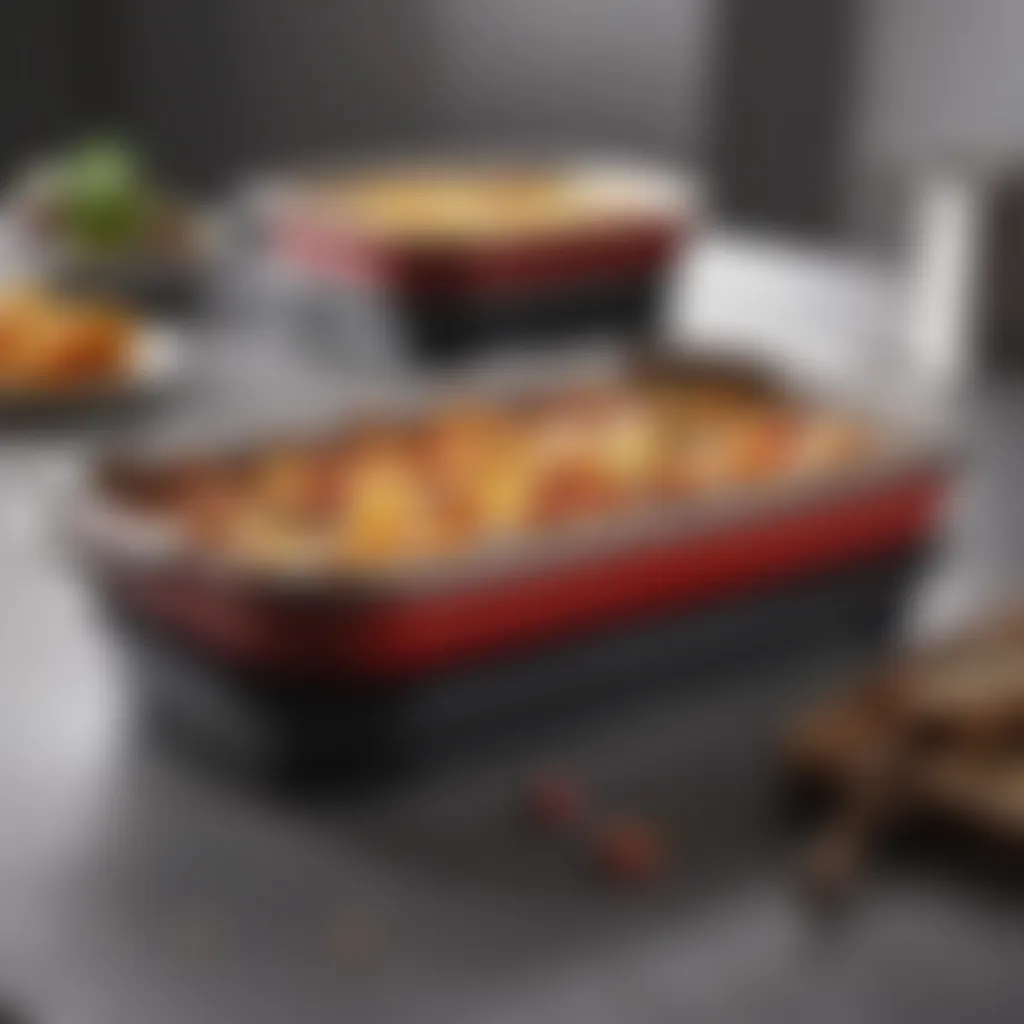
Intro
In a world where kitchen space is often at a premium, innovative solutions can make all the difference for a smooth culinary experience. Stackable pans with removable handles are becoming increasingly popular among home cooks who want to maximize both functionality and storage. These pans offer a blend of sophisticated engineering and practicality, designed to make cooking easier while also contributing to a more organized kitchen environment.
Gone are the days when you had to wrestle with heavy pots and pans that took up unnecessary space in your cabinets. This article aims to take you through the various features and advantages of these innovative cookware pieces, breaking down the way they can transform your cooking journey from preparation to serving.
By delving into the construction, materials, and ergonomic benefits of stackable pans, we’ll provide you with valuable insights that can help elevate your culinary practices. With this knowledge, you can make informed decisions when it comes to your kitchenware, allowing you to enjoy cooking without being burdened by the clutter of traditional cookware.
From understanding what ingredients work best with these pans to offering troubleshooting tips and ensuring that your cooking process is as efficient as possible, this article will serve as a comprehensive guide for those looking to enhance their kitchen adventures. So, let’s dive deeper and explore the functionality and advantages of stackable pans with removable handles.
Prelude to Stackable Pans
The introduction of stackable pans represents a shift in how we think about kitchen functionality and design. Gone are the days when space was a luxury many couldn't afford; now, innovative cookware allows for efficient use of space while maintaining performance. This section will delve into what makes stackable pans a game-changer in contemporary kitchens, particularly for those looking to maximize their culinary endeavors without overcrowding their cabinets.
Understanding Stackability
Stackable pans are designed to fit neatly into each other, saving precious space in your kitchen. This concept isn’t just about organization; it’s about enhancing our cooking experience. Imagine opening a cabinet filled with haphazard stacks of traditional pots and pans, each a potential hazard for spills and clanging. In contrast, stackable pans offer an elegant solution. They interlock or nest easily, allowing each piece to remain within reach without the clutter.
Moreover, this smart design extends beyond convenience. Stackability directly affects heat distribution and cooking efficiency. When plates and pots are appropriately stacked, they can retain heat more effectively, thereby improving cooking times and energy use. Thus, for those juggling a busy household, these pans are more than a pretty face—they’re your silent kitchen ally.
Significance of Removable Handles
The removable handle feature in stackable pans brings an additional layer of practicality. Think about it: when you’re cooking a feast, the last thing you want is a handle jutting out, making the pan awkward to stack or store. A removable handle elegantly circumvents this issue. It allows the user to detach the handle when not needed, making storage a breeze.
This innovation not only promotes an efficient kitchen but also enhances safety. Removing handles means that there’s less chance of accidental knocks or spills during storage. For instance, if you’re reaching into a cabinet while cooking, a protruding handle can create a risk. With these pans, you can simply remove the handle and feel assured that everything will stay in its rightful place.
Additionally, the flexibility of having removable handles means that one handle can often fit multiple pans. Less clutter, fewer items to juggle, and a considerable reduction in the chance of lost or misplaced cookware accessories. This compact and user-friendly design speaks volumes about evolution in kitchenware, propelling cooking enthusiasts and busy home chefs alike into a new era of culinary convenience.
Design and Innovation
The realm of kitchenware has evolved significantly over the years, with designs becoming more innovative and functional. In particular, stackable pans with removable handles represent a leap in cookware design. This section will dissect the importance of their design and innovation, shedding light on crucial elements that set these pans apart.
Engineering Challenges
One of the foremost hurdles engineers face when developing stackable pans is ensuring structural integrity while keeping the product lightweight. Pans need to withstand high temperatures and regular use, yet remain easy to handle. Engineers must consider the materials selected—each must meet performance standards without adding unnecessary weight.
Moreover, designing a reliable handle mechanism can be tricky. It needs to lock securely to prevent accidental disengagement during cooking yet release smoothly for easy stacking and storing. Balancing robustness with user-friendliness is a fine line to tread, and this challenge requires both creativity and technical skill.
Material Choices
When it comes to stackable pans, the choice of material is pivotal not only for performance but also for the aesthetic appeal. Most innovative cookware uses a blend of materials, often including high-grade stainless steel, non-stick coatings, and sometimes even cast aluminum. The goal is to provide excellent heat distribution while ensuring that the pans are durable and resistant to the wear and tear of daily use.
For instance, pans made with non-stick coatings make cooking and cleaning a breeze, as food slides off effortlessly, resulting in fewer frustrations during meal preparation. However, more recent innovations also focus on environmentally sustainable materials. Consumers are increasingly looking for cookware that reflects their values about being eco-friendly, prompting brands to explore biodegradable or recyclable options.
Aesthetic Considerations
In the world of cookware, design isn’t just about function. The look of the pans plays a significant role in consumer choices. Stackable pans that are aesthetically pleasing can elevate the overall kitchen ambiance.
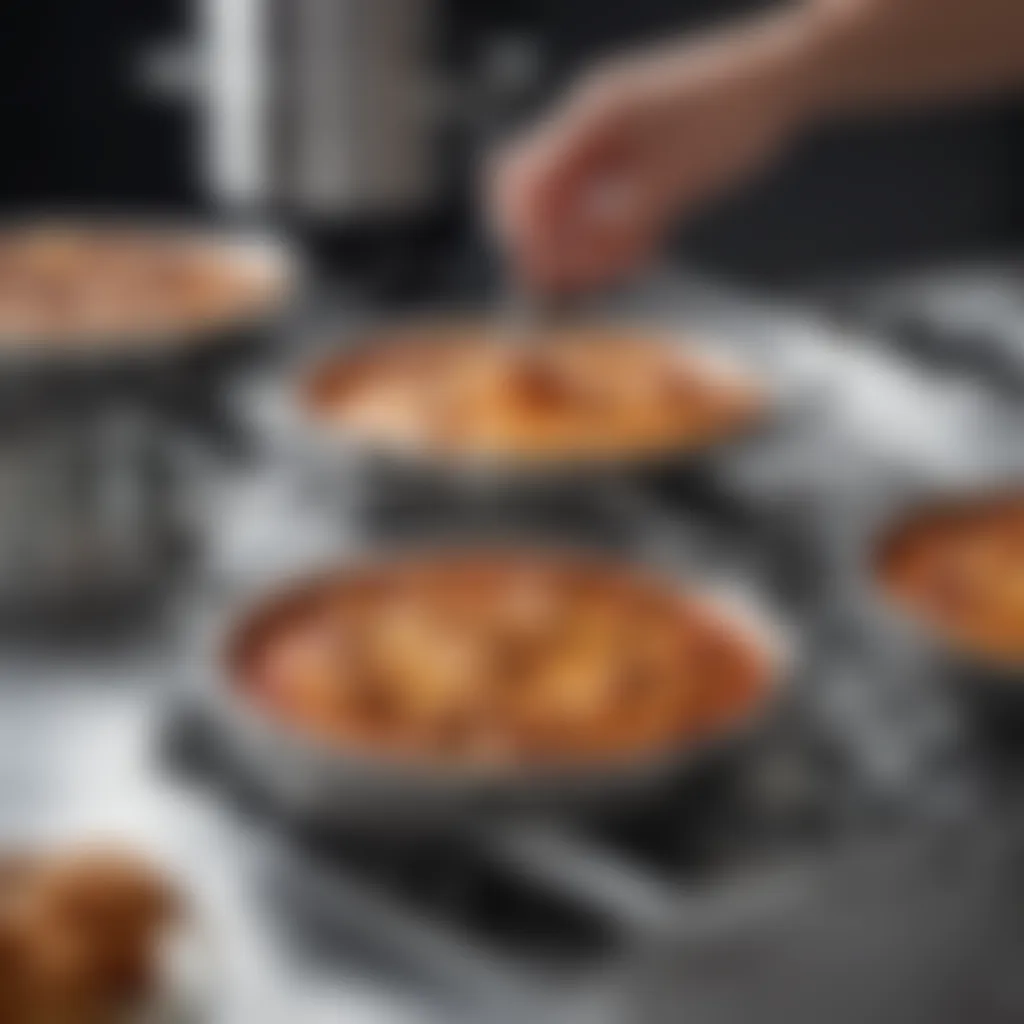

Many brands are now offering pans in various colors and finishes, allowing homeowners to mix and match with their kitchen decor. Furthermore, sleek and modern designs can also serve as an eye-catching display in a kitchen, transforming mundane storage into a decorative feature.
In this vein, it’s also important to consider the tactile ergonomics of the handles themselves: they should feel comfortable in hand. A well-designed pan not only performs well but does so in a way that adds to user satisfaction both during cooking and when displayed.
"Good design is not just what it looks like and feels like. Design is how it works." - Steve Jobs
Merging aesthetics with functionality is clearly essential in today's competitive cookware market. The manner in which these pans are designed, from shapes and materials to colors, all contribute to their appeal and usability, making them a thoughtful addition to any kitchen.
When tying together the intricate balance of engineering challenges, material choices, and aesthetic considerations, it's evident that the innovations surrounding stackable pans with removable handles are reshaping standards in kitchen ware. These evolving designs not only enhance usability but also reflect a blend of practicality and style, making cooking a more enjoyable experience.
Functionality in the Kitchen
Understanding the various functions of kitchenware goes beyond mere convenience. For stackable pans with removable handles, this functionality is essential to modern cooking—addressing the dual challenges of limited space and the need for effective cooking. As home chefs strive for efficiency and versatility in their culinary endeavors, these pans stand out by offering practical solutions to everyday cooking dilemmas.
Space Optimization
The kitchen is often considered the heart of the home, but it can also be one of the most cluttered spaces. In many households, especially smaller ones, optimizing space is crucial. Stackable pans with removable handles tackle this problem head-on. When these pans are not in use, their ability to stack efficiently minimizes clutter in cabinets and on countertops. This is particularly beneficial for those who might share kitchen space or have limited storage options.
Key benefits of space optimization include:
- Increased Storage Efficiency: By being able to stack pans, you can create more room for other cookware or kitchen essentials.
- Quick Accessibility: When pans are organized and compacted, you can quickly grab what you need without rummaging through a mess.
- Versatile Arrangements: Depending on your kitchen layout and storage solutions, these pans can be stacked in different configurations, maximizing every inch of space.
Moreover, the removable handles contribute to the practicality of storage. By detaching the handles, users can create even more space, making it easier to fit the pans into nooks that might otherwise go unused. The combination of stackability and removable components transforms how we visualize kitchen organization.
Culinary Versatility
Another significant aspect of the functionality of stackable pans lies in their culinary versatility. In today’s diverse cooking landscape, where different cuisines and cooking methods come into play, the flexibility of cookware is vital.
With stackable pans, you’re not just getting one type of cooking vessel; you’re acquiring a collection of vessels that can handle various tasks—whether it’s sautéing vegetables, frying proteins, or baking. Given that the cookware doesn't take much space, it opens up a world of possibilities for home chefs who want to experiment.
Benefits of culinary versatility entail:
- Multi-Purpose Use: Instead of needing a separate skillet for frying and a different pan for baking, you can easily switch between techniques using the same set of pans.
- Temperature Adaptability: Many of these pans are designed to withstand high temperatures, allowing for both stovetop and oven use—perfect for finishing off a dish in the oven after browning it on the stovetop.
- Enhanced Cooking Performance: The uniform heat distribution often found in well-engineered stackable pans ensures that food cooks evenly, which is essential for achieving ideal culinary results.
"Versatile cookware not only simplifies meal preparation but also enhances the dining experience at home."
In essence, the functionality of stackable pans powered by removable handles pertains not only to how these items save space. It is deeply intertwined with how these innovative tools empower home cooks to fully embrace their culinary ambitions without compromising quality or accessibility.
Ergonomic Considerations
When it comes to kitchenware, ergonomics plays a crucial role in ensuring not just functionality, but user satisfaction as well. Cooking is no small feat; it often involves long hours on one's feet, handling heavy pans, and ensuring safety while fire and heat dance dangerously close. With innovative stackable pans featuring removable handles, the design must cater to those very challenges.
Handle Mechanism Design
The design of removable handles is essential to how these stackable pans function. A well-designed handle should not only allow for easy removal and attachment but also provide a comfortable grip. Various manufacturers employ different locking mechanisms. Some utilize a simple push-button release, while others opt for a twist-lock feature. In either case, the aim is to ensure minimal effort when it comes time to detach the handle.
Additionally, the handle length and shape should be conducive to comfortable use. Handles that are too short can lead to the user experiencing discomfort or even strain. Conversely, overly long handles may risk tipping while cooking, creating a potential hazard. The balance of the entire pan is affected too. Ideally, the handle needs to feel natural in the hand, distributing weight evenly so that lifting a pot roast or a hearty soup becomes less of a chore.
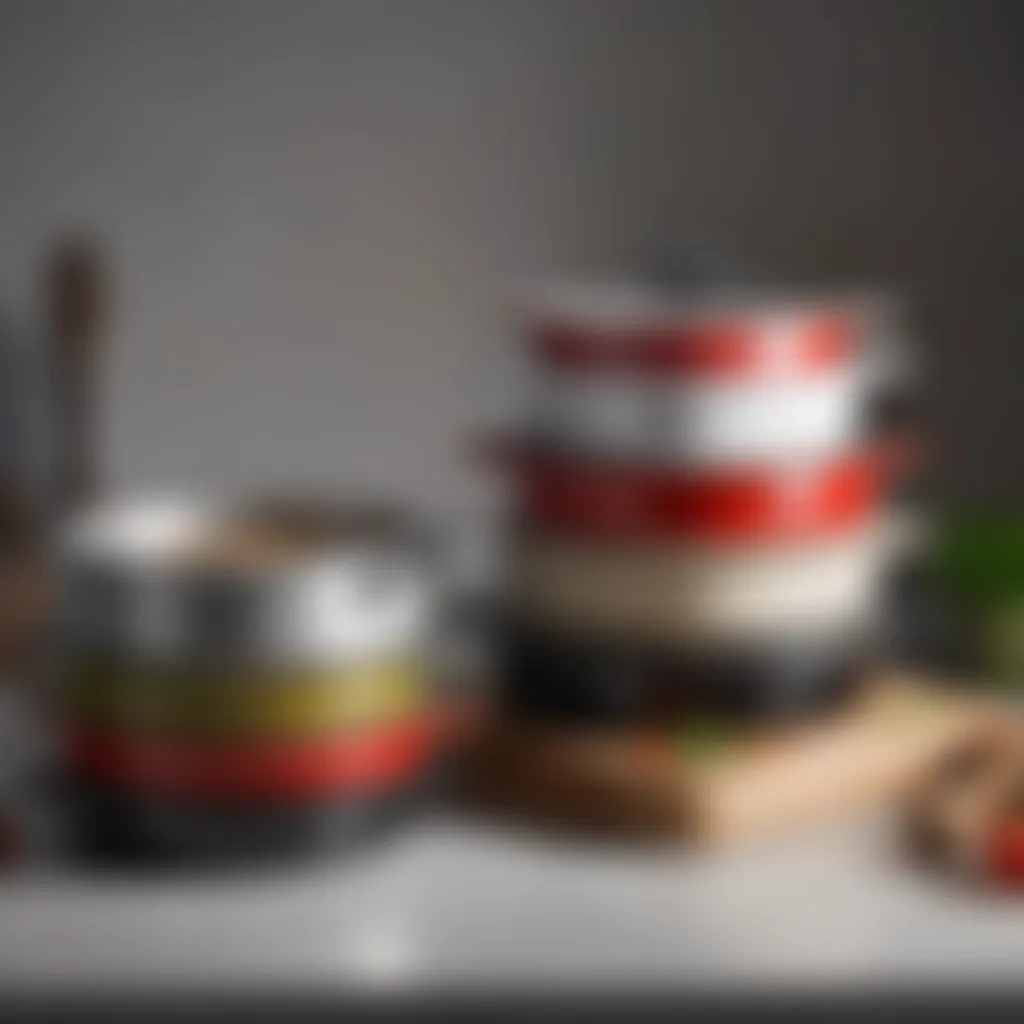

User Comfort and Safety
User comfort cannot be overstated, particularly for home cooks spending significant time in the kitchen. A well-thought-out design can mean all the difference between a pleasant cooking experience and a tiring, unsafe affair. Removable handle systems should ensure extra safety features, such as heat resistance. This is vital when dealing with hot pans. One uncalculated move can lead to burns, and that’s the last thing any cook wants to encounter.
Properly designed handles should include insulation or, at the very least, materials that do not conduct heat effectively. This way, the user can comfortably grasp the pan even during high heat cooking situations. Furthermore, the weight of the pans should also be considered. Heavier pans may pose a challenge during high-lift scenarios, while lightweight options may tempt one into careless handling.
"The combination of a well-designed handle and a lightweight structure not only enhances comfort but also significantly diminishes the risk of accidental spills or burns."
In addition to comfort, safety should always be on the forefront of any kitchenware consideration. This means the removal and attachment of the handle should be intuitive and clear to understand. Lack of clarity can lead to mishaps at a crucial moment in cooking. Careful attention to how these handles operate means a smoother cooking experience and a safer kitchen overall.
Overall, when selecting stackable pans, think about ergonomics. The right balance of design ease, comfort, and safety can pave the way for a more enjoyable and productive cooking experience.
Comparative Analysis
In delving into the realm of stackable pans with removable handles, a comparative analysis serves as a lens through which the value and advantages of these innovative cookware items can be evaluated against traditional cooking gear. This section aims to enlighten the readers about key distinctions, benefits, and considerations that inform their kitchen choices. The inquiry is not just about what is innovative but rather how it translates into real-life applications, especially for those who are consistently preparing meals in a busy household environment.
Stackable Pans vs. Traditional Cookware
When discussing stackable pans alongside traditional cookware, it's essential to dissect how their design enhances functionality. Stackable pans allow for a clever use of vertical space, which is often overlooked in kitchen designs. Conventional pots and pans can take up a sizable chunk of cabinet space, whereas stackable ones fit neatly on top of each other.
- Space-saving Solutions: Unlike the standard frying or sauté pans that can end up scattered in the cabinet, stackable pans neatly nest together, showcasing a more orderly approach to kitchen organization.
- Accessibility: When you need a specific pan, rummaging through a disorganized stack can be a vexing chore. With stackable pans, selecting the right piece becomes a cinch as they are all visible and reachable at a glance.
- Lightweight Design: Typically, stackable pans are crafted from lighter materials than their traditional counterparts. This not only aids in handling but also reduces the strain on shelves and cabinets.
From a practical standpoint, there are varying performance levels to note. Stackable pans often feature excellent heat conductivity due to their design, which can lead to more efficient cooking. Conversely, traditional cookware may offer sturdier options, like cast iron, which possess their own advantages for searing and slow cooking but do require more maintenance.
"Innovation in cookware doesn't mean abandoning what's already cherished; rather, it’s about enhancing usability while preserving culinary traditions."
Cost-Effectiveness Considerations
Cost is a significant concern for any household, and understanding how stackable pans fare in this regard compared to traditional cookware is crucial. There are various angles from which to analyze this:
- Initial Investment: Typically, stackable pans can be more affordable than high-end traditional sets, making them an appealing option for those watching their wallets.
- Space Efficiency: Fewer kitchen cabinets means you don’t just save money on cookware purchases, but potentially on cabinetry, too.
- Durability and Maintenance: Many stackable pans are designed with durable materials like stainless steel or non-stick surfaces, which can lead to longer lifespans and less frequent replacements compared to some traditional variations, especially when they require careful upkeep.
Ultimately, the value proposition of stackable pans becomes evident when you think about both upfront costs and long-term savings. For housewives like you, who often navigate between budget constraints and the desire for quality kitchenware, understanding these cost implications is vital.
Maintenance and Care
Maintaining stackable pans with removable handles is crucial to their longevity and function. Proper care not only ensures that they perform optimally but also preserves their aesthetic appeal, which is important in any kitchen setting. Investing time in cleaning and storage routines can make a significant difference in how well these innovative pans serve their purpose.
Cleaning Techniques
Cleaning your stackable pans is straightforward, yet specific techniques can enhance their life and performance:
- Immediate Rinse: As soon as you're done cooking, rinse the pans with warm water. Food residues are easier to remove if you tackle them right away.
- Use Non-Abrasive Cleaners: Opt for gentle sponges and non-abrasive cleaners to avoid scratching the surface. Many of these pans feature non-stick coatings, and scratching them can compromise their cooking performance.
- Soaking for Stubborn Stains: For burnt-on food or stubborn stains, fill the pan with hot, soapy water and let it soak for at least 30 minutes before scrubbing.
- Avoid Dishwasher Use: Unless specifically labeled as dishwasher-safe, it's best to hand wash to minimize wear and tear.
For best practices, a simple mixture of baking soda and water can help lift tough stains. Just sprinkle the baking soda on the stained area, add a dash of water, and scrub gently. This method is both cost-effective and environmentally friendly.
Storage Recommendations
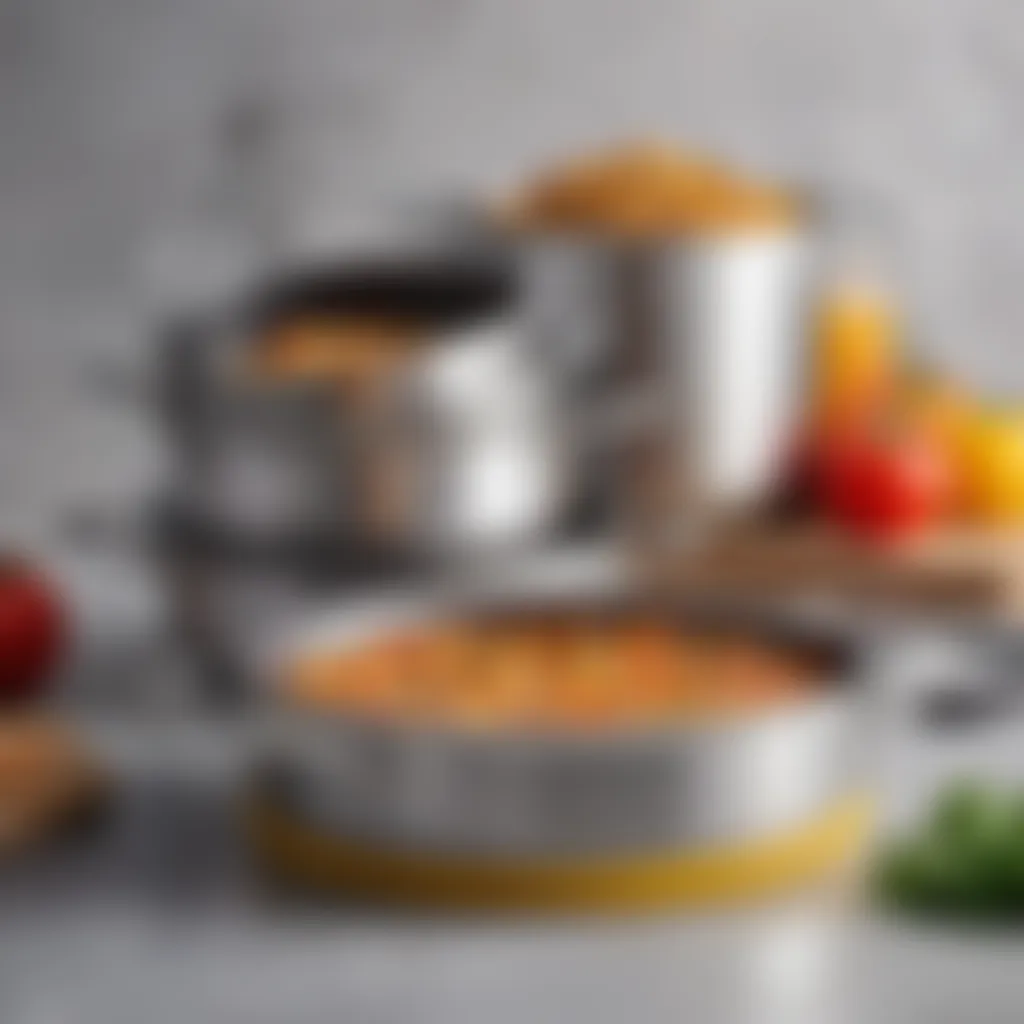
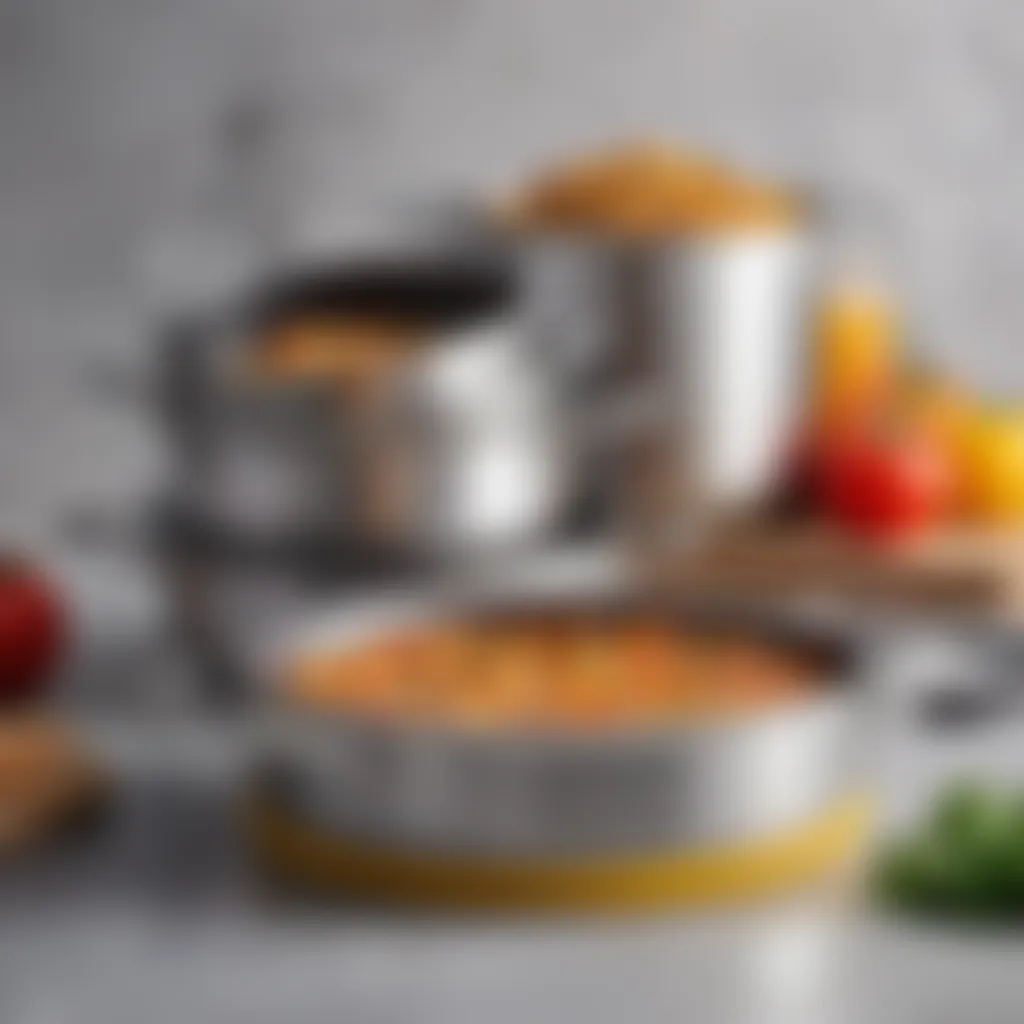
When it comes to storing stackable pans, proper technique can help you maximize space and maintain the pan's integrity. Here are important guidelines:
- Stacking Strategy: Make use of the stackable design by nesting the pans within each other. This not only saves space but also protects the surfaces.
- Handle Placement: If possible, store the removable handles separately in a designated drawer or container. This keeps them from getting lost and prevents scratches on the pans' surface from incidental contact.
- Use Protective Liners: Consider using cloth or silicone liners between stacked pans. This acts as a cushion, preventing scratching and maintaining the finish.
- Labeling for Easy Access: If you have multiple pans, labeling the storage container can save you time and effort searching for the right one.
Using thoughtful storage techniques not only enhances the appearance of your kitchen but also extends the life of your cookware.
In summary, attentive maintenance and conscious storage strategies play an essential role in maximizing the utility and longevity of stackable pans with removable handles. This sets the stage for countless culinary experiences, ensuring that you can focus on what truly matters—cooking and enjoying delicious meals without hassle.
Market Trends
When examining the landscape of kitchenware, understanding market trends helps illuminate not just what's currently popular but also the trajectory where the industry is headed. For stackable pans with removable handles, the role of market trends cannot be understated. These trends provide insight into consumer behaviors, preferences, and the innovations brands are making in response to them.
Consumer Preferences
Consumer preferences today show a pronounced shift towards multifunctional, space-saving kitchenware. It's like shoppers are armed with a checklist—versatility, ease of storage, and aesthetic appeal top the list. Stackable pans with removable handles are right at home here. They cater to the desire for a clutter-free kitchen environment while allowing users to maximize their cooking potential.
For instance, a young couple in a cozy apartment may favor stackable pans over traditional sets because they can be neatly tucked away in one another, saving precious cabinet space. The removable handles allow for easy transfer from stovetop to oven, enhancing usability. This combination resonates well with both millennials and busy families. The stacking feature, in particular, speaks volumes to those looking to streamline their cooking routine.
In surveys, consumers frequently highlight ease of cleaning and storage as a decisive factor. When it comes down to upkeep, stackable pans that nest offer a significant advantage. Users appreciate that less space taken up means less time spent rummaging through cabinets to find the one saucepan or skillet they need.
Brand Innovations
As consumer preferences evolve, brands are scrambling to innovate, and this is evident across various manufacturers of stackable cookware. Companies are not just resting on their laurels; they're pushing the envelope on design and function. This includes experimenting with materials that resist scratches, stains, and provide even heat distribution.
For instance, brands like Tefal and GreenPan have integrated ceramic non-stick coatings into their stackable pan designs. These innovations promise durability and an easier experience in the kitchen. Additionally, some brands are beginning to offer customizable handle designs, allowing consumers to mix and match colors and styles, thus reflecting personal tastes in the kitchen.
It’s noteworthy that many brands are not just focusing on functionality; they’re also tapping into sustainability. Increased consumer awareness regarding environmentally friendly products is driving brands to develop eco-conscious materials for their cookware lines, catering to a demographic that prioritizes green living.
"As consumers become more informed, brands must adapt or risk falling behind. It’s a fascinating shift that’s reshaping kitchenware."
In wrapping up this exploration of market trends, it shines a light on how stackable pans with removable handles are not just products but part of a larger cultural movement in the kitchen. They not only meet practical needs but also cater to a lifestyle where convenience and aesthetic appeal reign supreme.
Culmination
In closing, the exploration of stackable pans with removable handles reveals why they represent a significant advancement in modern kitchenware. These innovative tools do more than just promise efficiency—they deliver on multiple fronts. One of the main takeaways is the ability of these pans to conserve valuable kitchen space, which can be a real game-changer in smaller homes or apartments where every square inch counts. Their clever design allows for easy storage without compromising cooking performance, something that cannot be overstated.
Recap of Benefits
When reflecting on the advantages these pans provide, a few key benefits stand out:
- Space-saving design: The ability to stack pans reduces clutter in cabinets and allows for organized storage.
- Customizability: Removable handles offer flexibility for handling different pan sizes, making them suitable for a wide range of culinary tasks.
- Easier cleaning: With fewer parts to worry about, cleaning becomes less of a chore.
- Enhanced safety: Users can handle pans without the risk of burning their hands on hot handles.
Akin to opening a treasure chest, these pans reveal hidden gems of functionality each time they are used, allowing even the busiest home cooks to maximize their efficiency without sacrificing quality.
Future of Kitchenware Design
As we look to the horizon, the future of kitchenware seems increasingly geared towards innovation that prioritizes convenience and efficiency, much like the stackable pans we’ve discussed. Companies are likely to continue experimenting with materials that promote longevity and ease of use, while integrating more ergonomic features to enhance comfort. Tech-inspired designs could eventually make their way into cookware, like heat-sensing technology or even smart materials that change based on cooking conditions.
"The kitchen remains the heart of the home, and as such, it deserves tools that adapt to our lives, not the other way around."
The design philosophy is shifting to meet modern demands, pointing towards a landscape where kitchenware evolves along with lifestyle needs. Hence, we can expect products like stackable pans to only become more refined and accessible, ensuring they suit the cooking habits of diverse households. The drive for sustainable and minimalist design will likely see stackable pans incorporating biodegradable materials or modular designs that can easily adapt to different cooking styles.
In summary, the functionalities found in stackable pans wield the power to reshape our approach to cooking and kitchen management, making the journey from prep to plate not just simpler, but also more rewarding for everyone involved.







